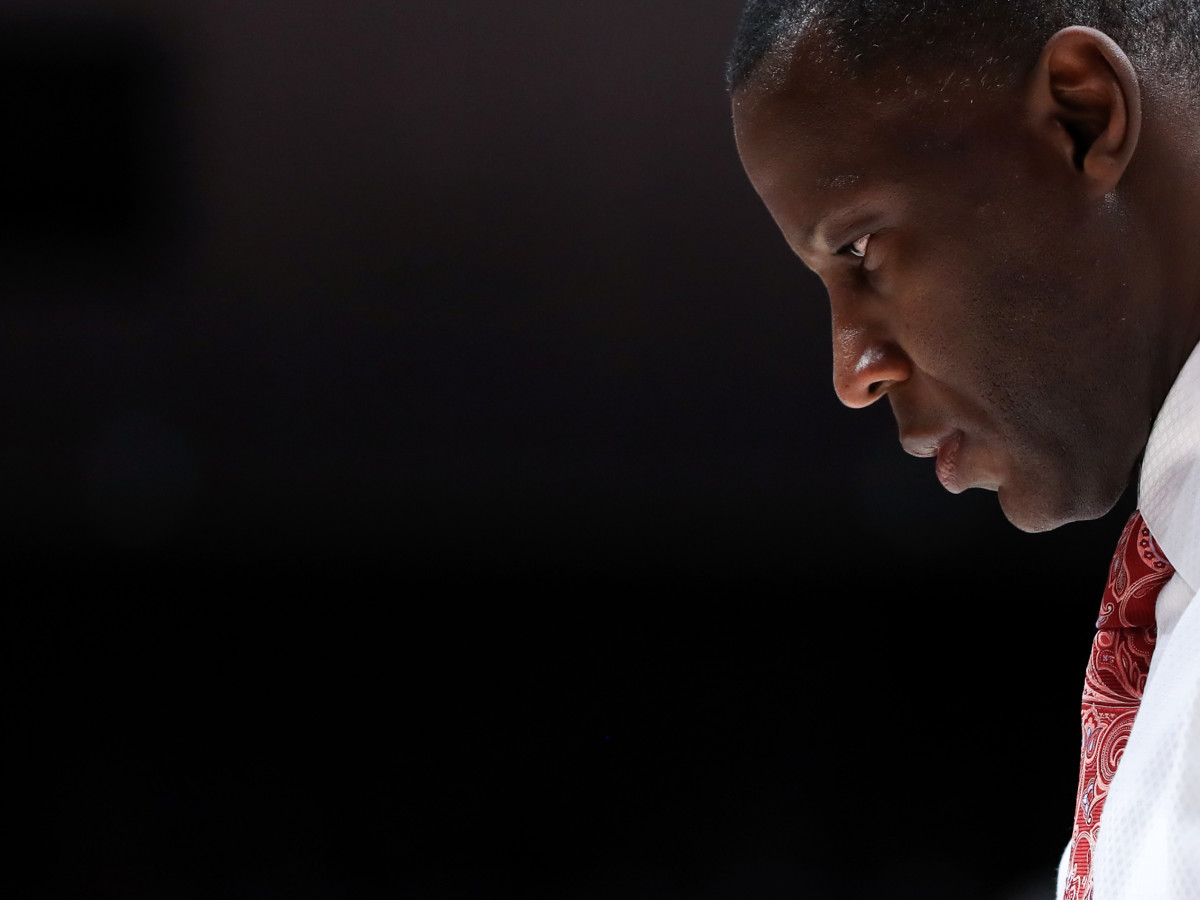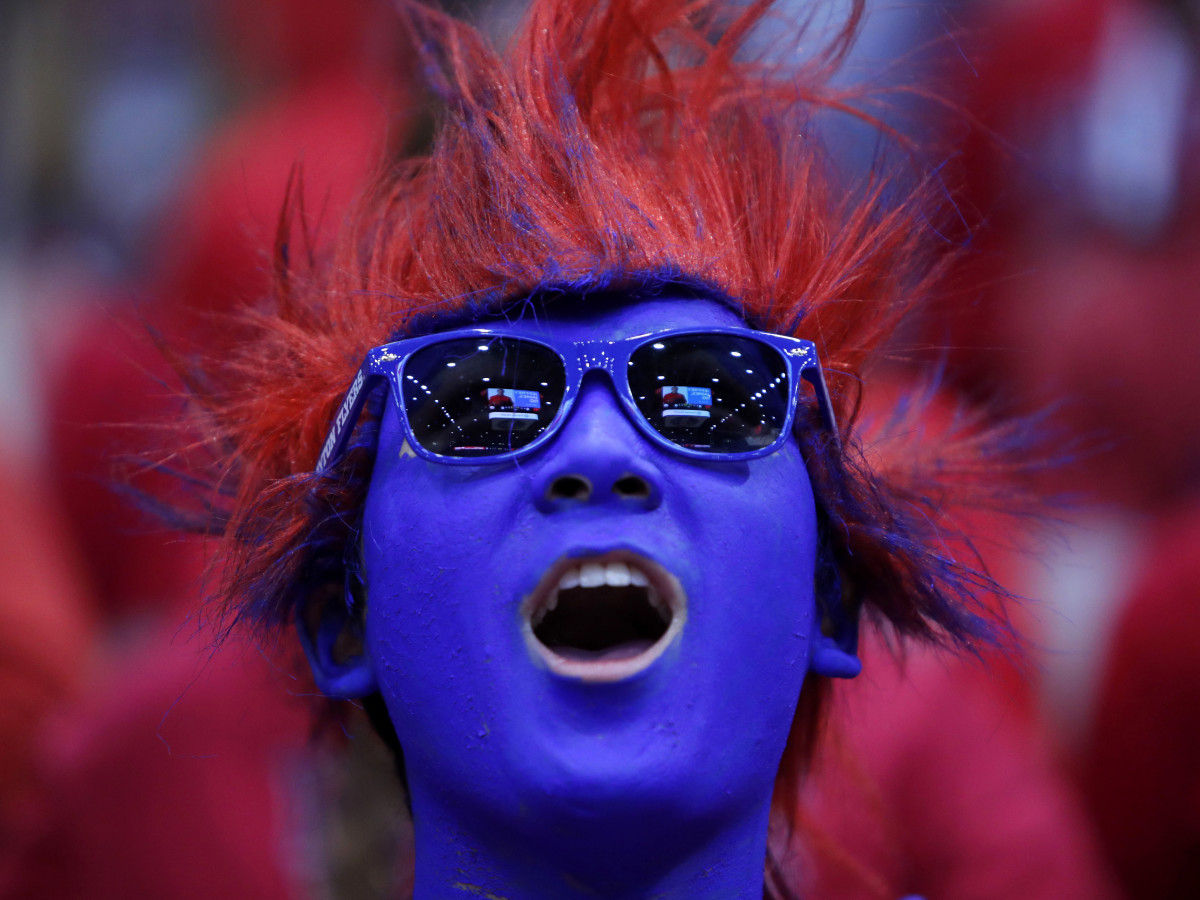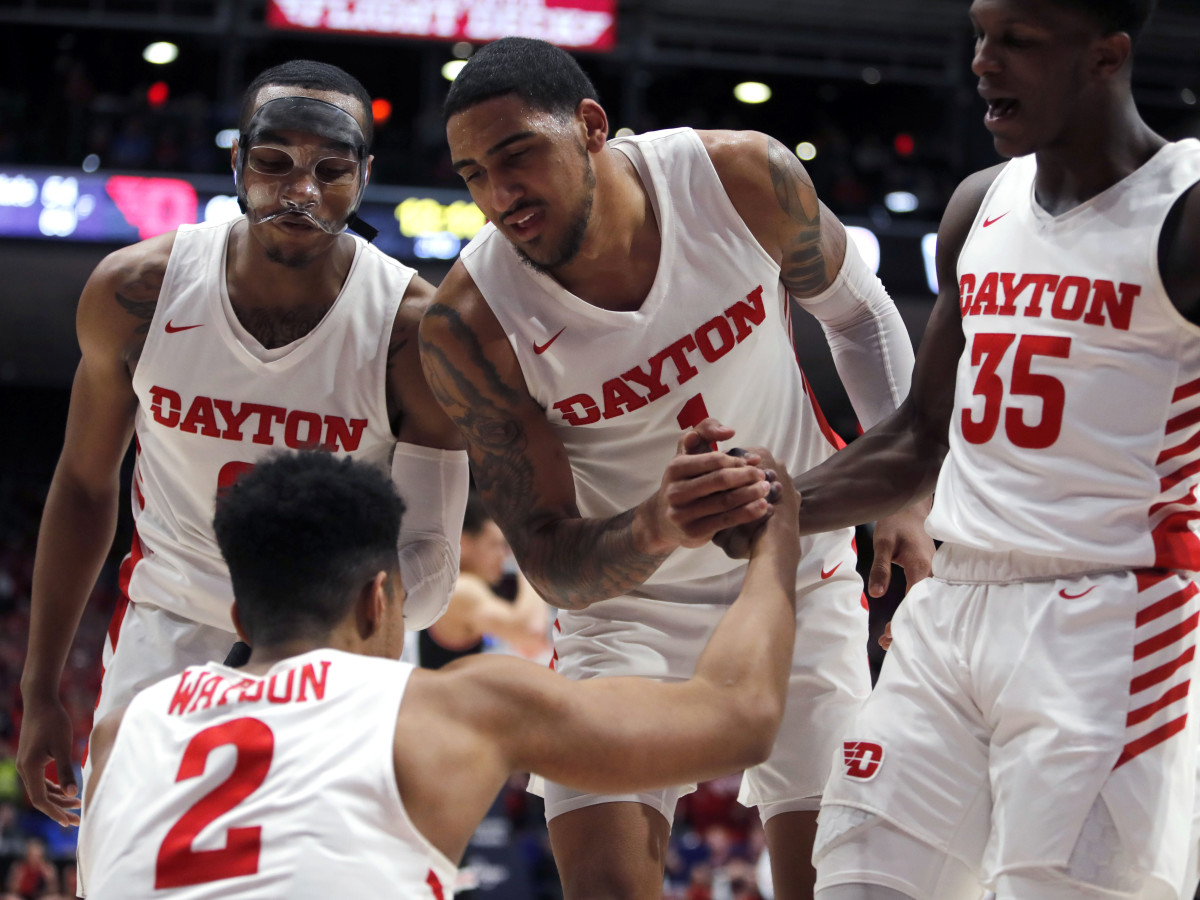Dejection Sunday Looms Over Dayton After Abrupt End to Cinderella Season

DAYTON, Ohio — Dejection Sunday dawned cold and gray, the last traces of a Saturday snow on the ground and melancholy in the air. It is quiet here. Almost lifeless.
It wasn’t supposed to be this way on March 15, 2020. If the world were still right, this would be a vibrant place on this day. In an ideal Dayton, the hometown Flyers—the most surprising success story of the season in college basketball—would be in Brooklyn preparing to play in the Atlantic-10 Conference tournament final, then finding out if they earned the school’s first NCAA tournament No. 1 seed. Meanwhile, the city would be cranking up preparations for its annual pet project, hosting the First Four games on Tuesday and Wednesday.
It would be the most exciting of all Selection Sundays in Dayton. Instead it is Dejection Sunday.

“It’s all a little too fresh right now,” said the coach of the Flyers, Anthony Grant. “Like everyone else, I’m dealing. You go through moments thinking about what we accomplished where you say, ‘That was fun.’ Then you go through your moments where you say, ‘I wish we were playing.’ We should be playing for a championship today.“
Nobody is playing anywhere, now that the coronavirus pandemic has shut down sports in America. The issues are much larger than athletics, of course, but what’s been lost in that realm is perhaps felt more acutely here than anywhere in America.
The swing of emotions, altering of moods and deflation of energy here from one week to the next is palpable and profound. I was here March 6–8, and it was the happiest place in the college basketball world. I came back this weekend, and what I found was just plain sad.
***
This is the Dayton I saw on March 7:
House parties were raging on Kiefaber Street, in the heart of The Ghetto—also known as the South Student Neighborhood, if you prefer to adhere to University of Dayton official terminology. (No one does.) The sun was out, a blessed Midwestern bonus that you can never count on in early March. The students were out, hanging bedsheet signs on their porches. The Flyers were flying at 28–2, and the alcohol was flowing in front yards up and down the block.
ESPN’s College GameDay was on campus in the morning. Later, No. 5-ranked Dayton would play its final regular-season game against George Washington. In between, on this blue-sky afternoon, the student body at a Catholic school of 11,000 was celebrating a season like no other. The block was overrun with kids in Dayton jerseys and “Toppin/Crutcher 2020” campaign-style shirts.
“It’s f------ insane,” said junior Greg L., not wishing to give his last name, as he pulled on a bottle of Crown Russe vodka (not exactly the good stuff). “Nobody expected anything this season and we’re just all going nuts. If they make the Final Four, I’m burning a couch in the street.”
Standing next to Greg L., fellow junior David Stanko faced the street and held up a cardboard sign that says, “You honk, we drink.” There had been a lot of honking, and the group of boys in the yard did their best to keep up their end of the bargain.
The row houses were built decades ago to serve as housing for National Cash Register employees, when that was headquartered in Dayton and employed a huge number of locals. Eventually they were taken over by students and most were bought up by the university itself. The party scene in the Ghetto was always strong, but the confluence of weather and basketball mania took the place to a level normally reserved for St. Patrick’s Day.
When asked I asked the boys whether they lived in the house behind them, they all laughed.
“No clue who lives there,” said one of the boys. “This is the Dayton Way. You can go into any house, you don’t have to know anyone. There’s free Natty Light for everyone. It’s heaven with alcohol.”
With or without the alcohol, the Dayton of March 7 was college hoops heaven on earth. The Flyers were champions of the Atlantic-10 and led the league in attendance by a wide margin, averaging 13,364 fans per home game. The Wright State Raiders, nine miles away, won the Horizon League and led that league in attendance, averaging 4,734. The two teams were a combined 54–9.
Here in this special season, it seemed time for a city that loves its basketball to tie the entire NCAA Tournament circle of life together—from hosting the First Four to sending a team to the Final Four.

“We’re a basketball town,” said Dayton mayor Nan Whaley, a graduate of the school. “The rest of Ohio loves its football, but we don’t have a pro team or a major college (football) program here. I think that’s why the First Four has been so successful—we have always gotten behind basketball. But to have the Flyers the best they’ve really ever been takes it to a new level. The arena has been on fire. It’s a great time to be a Flyer.”
The crowd at University of Dayton Arena is like many other longtime basketball communities—the old folks have most of the good seats, with the students raising a ruckus in one end zone. But the seats are always full, and the gray-haired fans will get on their feet and get after it more than you might encounter in, say, Rupp Arena or the Dean Dome. Against George Washington, the lower sections were on their feet almost the entire second half as the Flyers turned a close game into a 25-point rout with a flurry of Obi Toppin dunks.
“You’ve got 80-year-olds who are as into it as 18-year-olds,” said 2018 Dayton graduate Caroline Deeley. “They are not boring, sit-on-your-ass people.”
And they are there every night. Assistant coach Anthony Solomon noted that the Flyers drew a full house for a Dec. 23 game against overmatched Grambling.
“Some places, they come to see the opponent,” Solomon said. “Here, they come to see the Flyers.”
Except for two days a year. Then, Dayton comes out to see eight visiting teams with which they are not affiliated.
Those teams play in the First Four, a pair of doubleheaders on the Tuesday and Wednesday that tip off the NCAA Tournament. This was an expansion of the tourney that began in 2001 with a move from 64 teams to 65, and just a single game in Dayton between what was usually the two lowest-seeded teams in the entire tourney. Then the NCAA expanded to 68 in 2011.
The move was derided nationally as a naked money grab by the NCAA, part of pumping up the price of its new broadcast contract with CBS and Turner Sports. The games would match the last four at-large programs in the field, plus four No. 16 seeds from the bottom of the bracket.
Everyone thought the idea would flop. Until Dayton embraced it like a big deal. That helped make the First Four legitimate, and along the way the city earned the right to become its permanent host.
“It was never the plan to go beyond the award of a few years,” said Greg Shaheen, the former NCAA vice president and tourney czar who gave birth to the First Four idea. “But from the get-go, it was a great partnership. All credit to everyone in Dayton throughout the years that worked to make this something special.
“There was a clear energy that this was important, and they wanted to make it their own. The reality is, they delivered. The people critical of it, more often than not, have never been to Dayton.”
If you come to Dayton for the First Four or at any point during basketball season, you must visit the Ghetto. And if you visit the Ghetto, you also must make a swing by Milano’s, a popular sports bar in the area.
On March 7, college basketball was on every TV. Every table was taken. So was every bar stool. On the wall were more than 100 pictures of members of The Century Club—form a group, and if at least one of you visits the bar every day for 100 days, you’re in the club and on the wall.
On a sunny day, when the house parties are booming, the kids were rocking the Ghetto. The alums were holding it down at Milano’s.
Tim Glancey, Class of 1990, was back with some of his classmates to catch the Flyers’ last home game. He traveled south from Toledo for this, ignoring doctor’s orders after shoulder surgery just two days earlier. Arm in a sling, he was putting his other hand to good use holding a beer.
“It’s like the fountain of youth coming back here,” Glancey said.
Like everyone else, he was anticipating the Flyers drawing Cleveland for the first and second rounds of the NCAA Tournament. He would definitely be there for that as well. Everything was aligning for Dayton’s first Final Four since a Cinderella run to the title game in 1967.
And then the coronavirus canceled March Madness.
As last week progressed, everyone became increasingly nervous about the state of sports—particularly college basketball at tournament time. With disorienting speed, the dominoes fell: leagues made decisions to play tourneys, but without fans. Then that, too, became questionable.
Grant was heading to The Barclays Center in Brooklyn on Thursday morning to scout the Massachusetts-VCU game—his Flyers would play the winner Friday. He got word en route that some leagues were thinking of canceling their tournaments, including the A-10. When he walked into the arena and waited for an elevator to head down to the court level, Grant looked at a TV monitor and saw UMass coach Matt McCall call over the game officials and make a motion—the game was canceled. The whole tournament was canceled.
Crestfallen, Grant and his staff returned to the team hotel and informed the players. Then they prepared to leave. When they got to the airport and boarded their plane, prepared for takeoff, they got the latest update: the NCAA Tournament was canceled as well.
The season was over. For seniors Trey Landers and Ryan Mikesell, treated to standing ovations on March 6 by an adoring home crowd, their careers were over. Just like that.
“It was a quiet trip back,” Grant said. “We met when we got back, and there was a lot of emotion. I told them that we got to play 31 games, just a heck of a run. What they did this year will never be erased.
“But we wanted to do more. There are a few programs out there that could say, with the right matchups, they could compete for a championship. We were one of them.”
Asked what he’s going to do with a suddenly empty three weeks, Grant laughed.
“My kids all have Netflix accounts,” he said. “They’ve been kind enough to share their passwords.”

***
Here is the Dayton I saw on March 14:
The Ghetto was empty. The school is on spring break, so that makes sense, but even the few remaining students were inside as the snow swirled in a biting wind. A week ago, everyone was outside celebratin’ Dayton.
The aura in Milano’s Saturday afternoon could not have been more divergent from the bustling scene seven days earlier. There was exactly one table of patrons in the dining room, and nine people seated at the bar. All conversation was muted. Nobody laughed.
The TVs that showed wall-to-wall college basketball on March 7 were tuned to an array of non-sequitur channels for a sports bar: Food Network, Cartoon Network, Vice. There was no sports to show, and it seemed to be bad business to show news channels that were doing nothing but advising people to stay home.
The song piped into the place was Lenny Kravitz singing, “I want to get away. I want to flyyyy awaaayyy.”
Didn’t we all?
Manager Steve Sarles checked on his patrons, but there wasn’t much to do.
“Honestly, it’s a nightmare,” he said of the precipitous decline in business. “From where we expected to be today to where we are, it’s an absolute nightmare. I feel bad for my staff.”
Even with the students on spring break, there normally are enough Dayton fans in the neighborhood to keep things going until the big payoff—the First Four games just a mile away at the arena. Bringing eight programs to town was always a guaranteed bonanza for a couple of days, and that fed directly into the packed houses of the first few days of the main draw of the NCAA tournament.
“Brick and mortar stores have Christmas,” Sarles said. “Restaurants like us have the NCAAs.”
And this year, the NCAAs were going to feature the Dayton Flyers in an unprecedented starring role.
“It was a nice ride,” Sarles said. “You just hate to see how it ended.”
It ended in a boardroom in Indianapolis, and it’s wrong to blame anyone for that decision. There was nothing anyone could do to save this season, the most special in Dayton history.
In the span of a surreal few days, the happiest place in college basketball became the saddest. Selection Sunday is Dejection Sunday here, and there is no fixing that.
